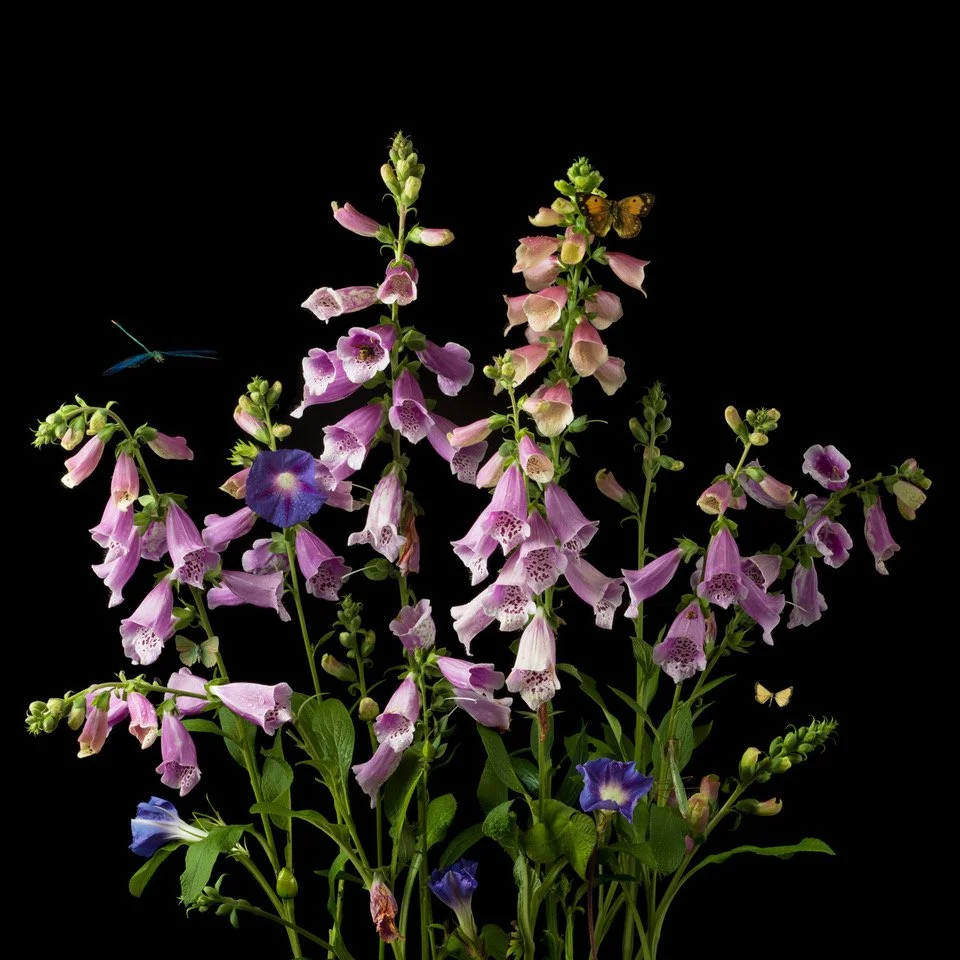
Portraits in Bloom: 2023 - Ongoing
Rooted in the memories of her grandmother’s garden, Tavormina elevates the flowers she cultivates in her Connecticut garden into refined, timeless photographic portraits. Inspired by 17th-century Master still lifes, each composition captures blooms in every stage of life—from tightly furled buds to softly fading petals—while butterflies and insects underscore the delicate interconnectedness of the natural world. The series meditates on the ephemeral beauty of nature and the enduring ties of memory, family, and personal history. Discover the full story in Tavormina’s Portraits in Bloom essay below to explore the deeper narrative behind the images.
For exhibitions, licensing and creative collaborations, please contact the artist directly. Email: paulette@paulettetavormina.com. For information regarding pricing and editions, please contact one of the galleries presented on my Acquire & Contact page.
-

Purple Peonies, 2025
-

Lavender Delphiniums, 2025
-

Grand Dahlias, 2024
-

Foxgloves, 2024
-

Purple Tulips, 2024
-

Pink Tulips, 2024
-

Fritillaria, 2024
-

Pink Roses, 2024
-

Zinnas, 2024
-

Sunflowers, 2024
-

Purple Iris, 2024
-

Lilacs, 2024
-

Hydrangeas, 2024
-

Dahlias, 2023

Portraits in Bloom:
Essay by Paulette Tavormina
Flowers depicted in 17th-century Old Master still life paintings have had an immense influence on my photographic imagery. The flowers adorning those canvases were not merely decorative; they were rich in symbolism and cultural meaning. Wilting blooms, for example, symbolized the brevity of life — a reminder that beauty, wealth, and earthly pleasures are fleeting. During the Dutch Golden Age, painters conveyed their patrons’ wealth while showcasing a growing interest in botany and the natural sciences.
I’ve always been drawn to flowers, ever since spending time in my grandparents’ garden on Long Island. My grandfather was an avid gardener. His flourishing garden of flowers, vegetables, and raspberries that spilled over the neighbor’s fence — which I loved to pluck — remains one of my most cherished memories. He built glass cold frames and grew seedlings; his garden included peach and Italian plum trees, plate-sized dahlias, and fig trees, among many other specimens. I still have a fig tree grown from a cutting of his, along with dozens of flowers I cultivate for use in my photography and to beautify my home. My grandmother won blue ribbons for her exquisite roses, and my mother also loved flowers, many of which now grow in my Connecticut garden.
“Some are budding, others are wilting — capturing the beautiful, inevitable cycle of life.”
When I began this new series, Portraits in Bloom, I chose not to place flowers in vases within a traditional still life tablescape. Instead, I decided to portray them as the central subject. I was inspired by 17th-century Old Masters such as Jan van Kessel and Maria Sibylla Merian, artists who celebrated individual flowers and petals by illustrating their intricate nature. Both documented botanical life as it was, rather than presenting flowers with allegorical symbolism. In my series, I depict flowers alongside butterflies and insects — both as portraits of the individual bloom and, at times, with allegorical meaning. Some are budding, others are wilting — capturing the beautiful, inevitable cycle of life.
The flowers — Peonies, Lilacs, Sunflowers, Zinnias, Irises, Roses, Fritillaria, Tulips, Dahlias, Hydrangeas, Delphiniums, and Foxglove — are all grown in my garden in Connecticut.
